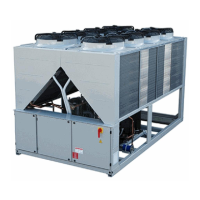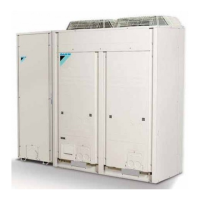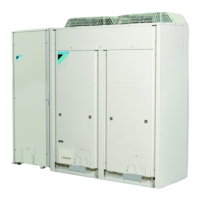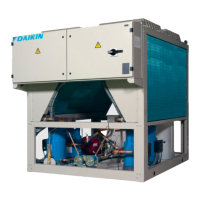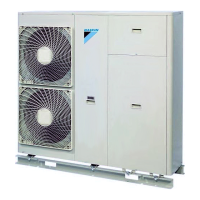D-EIMAC01207-15EN - 8/22
Positioning and assembly
The unit must be installed on a solid, perfectly level
base. For earthing purposes, a solid cement base, that
is wider than the unit, must be made. This base must be
able to support the weight of the unit.
Anti-vibration supports must be installed between the
frame of the unit and the cement base of the steel
beams; for such installation follow the dimensional
drawing supplied with the unit.
The frame of theunit must be perfectly levelled during
installation, if necessary using shims to be inserted
under the the anti-vibration supports.
Before first start-up, the installation must be confirmed
as being level and horizontal using a laser level or
another suitable instrument.
Any error in the level and horizontal position must not
be greater than 5 mm per unit up to 7 metres and
10mm per unit over 7 metres.
If the unit is installed in places that are easily accessible
to people and animals, we recommend that protection
grates are fitted all round to prevent access. To ensure
optimal performance in installation site, the following
precautions and instructions must be respected:
- Make sure that there is a strong, solid foundation to
reduce noise and vibrations.
- Avoid installing the unit in areas that could be
dangerous during maintenance operations, such as
platforms without handrails, guide rails or in areas that
fail to comply with requirements as regards free space
around the unit.
The installer is responsible for calculating the best
position for the unit.
It is vital that all minimum distances for all units are
complied with to ensure there is adequate ventilation for
the condenser racks.
When deciding where to position the unit and to ensure
proper airflow, the following factors must be taken into
consideration:
avoid the recirculation of hot air
avoid insufficient air supply for the air cooling
condenser.
Both these conditions can cause an increase in
condenser pressure which can lead to poor energy
efficiency and refrigerating capacity.
If two or more units are positioned alongside each
other, we recommend leaving a space of at least 3600
millimetres between condenser racks. Each side of the
unit must be accessible for post-installation
maintenance work.
It is therefore vital that the minimum access distances in
front of the electrical panel are complied with: 1500 mm.
The manufacturer cannot be expected to consider all
these factors. In the unit design stage, we therefore
recommend that you consult an authorised
manufacturer representative for further solutions.
Figure 3 - Distances to be complied with:
Noise
The noise generated by the unit is mainly due to the
rotation of compressors.
The noise level for each model size is listed in sales
documentation.
If the unit is correctly installed, operated and
maintained, noise emission levels do not require any
special protective devices to operate continuously close
to the unit without any risk.
In case of installation with special noise requirements it
may be necessary to install additional noise softening
devices.
Handling and lifting
The unit must be lifted with the utmost care and
attention, following the lifting instructions shown on the
label applied to the electric panel. Lift the unit very
slowly, keeping it perfectly level.
Avoid bumping and/or shaking the unit during handling
and loading/unloading operations from the
transportation vehicle, push or pull the unit only using
the base frame. Secure the unit inside the truck to
prevent it from moving and causing damage. Do not
allow any part of the unit to fall during
loading/unloading.
All units have lifting points. Only these points may be
used for lifting the unit, as shown in the following figure.
Handling and lifting with a fork lift is the only alternative
method.
Both the lifting ropes and the spacing bars must
be strong enough to support the unit safely. Check
the weight of the unit on its name plate, because

